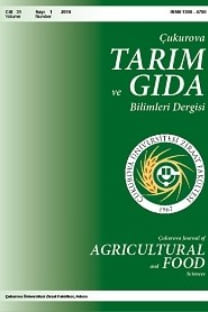Çukurova Bölgesi’nde Elma ve Şeftali Ağaçlarında Solgunluk ve Kök Boğazı Çürüklüğü Etmeni Pythium nodosum’un Tanılanması ve Patojenisitesi
Besi Ortamları, ITS bölgesi, Patojenisite, PCR, Radyal Gelişim
Identification and Pathogenicity of Pythium nodosum Causing Wilting and Crown Rot of Apple and Peach Trees in Cukurova Region
Culture media, ITS Region, Pathogenicity, PCR, Radial Growth,
___
- Anonim, (2016) Türkiye İstatistik Kurumu (Erişim tarihi: 17.06.2016, 20:43)
- Chen, W. (1992) Restriction Fragment length Polymophisms in enzymatically amplified ribosomal DNAs of three heterothallic Pythium species Phytopathology 82:1467-1472
- Cooke, D.E.L., Drenth, A., Duncan, J.M., Wagels, G., Brasier, C.M., (2000) A moleculer phylogeny of Phytophthora and related Oomycetes. Fungal Genetics and Biology 30:17-32.
- de Cock, A.W.A.M., Lodhi, A.M., Rintoul, T.L., Bala, K., Robideau, G.P., Abad, Z.G., Coffey, M.D., Shahzad, S., and Lévesque, C.A. (2015) PhytoPythium: molecular phylogeny and systematics. Persoonia 34: 25-39.
- Dervis, S., Soylu, S., Serce, C. (2014) Corm and root rot of Colocasia esculenta caused by Ovatisporangium vesans and Rhizoctonia solani. Romanian Biotechnological Letters 19(6):9868–9874.
- Erwin, D. C. ve Ribeiro, O. K., (1996) Phytophthora Diseases Worldwide. American Phytopathological Society, St Paul, Minnesota. 562s.
- Duncan, J. ve Cooke, D. (2002) Identifying, diagnosing and detecting Phytophthora by moleculer methods. Mycologist 16:59-66.
- Hendrix,F. F. ve Campbell, W. A. (1973) Pythiums as plant pathogens. Annual Review of Phytopathology 11: 77–98.
- Jeffers, S. N. ve Martin, S. B. (1986) Comparison of two media selective for Phytophthora and Pythium species. Plant Disease 70(11): 1038–1043.
- Lévesque, C. A. ve De Cock, W. A. M. (2004) Molecular phylogeny and taxonomy of the genus Pythium. Mycol. Res. 108 (12): 1363–1383.
- Mazzola, M., Andrews, P. K., Reganold, J. P., Lévesque, C. A. (2002). Frequency, virulence, and metalaxyl sensitivity of Pythium spp. isolated from apple roots under conventional and organic production systems. Plant Disease 86:669-675.
- Mcleod, A. l., Botha, W. J., Meitz, J. C., Spies, C. F. J., Tewoldemedhin, Y. T., Mostert, L. (2009) Morphological and phylogenetic analyses of Pythium species in South Africa. Mycological Research 113:933–951.
- Mircetich, S. M. (1970) The Role of Pythium in Feeder Roots of Diseased and Symptomless Peach Trees and in Orchard Soils in Peach Tree Decline. Phytopathology 61:357-360.
- Nakova, M. (2010) Monitoring of Phytophthora species on fruit trees in Bulgaria. European Journal of Plant Pathology 128:517-525
- Paul, B., Galland, D., Bhatnagar, T., Dulieu, H. (1998) A new species of Pythium isolated from the Burgundy region in France. FEMS Microbiology Letters 158: 207-213
- Paul, B. (2000) ITS1 region of the rDNA of Pythium megacarpum sp. nov., its taxonomy, and its comparison with related species. FEMS Microbiology Letters 186: 229–233.
- Paul, B. (2001) ITS region of the rDNA of Pythium longandrum, a new species; its taxonomy and its comparison with related species. FEMS Microbiology Letters 202:239–242.
- Ribeiro, O. K. (1978). A Source Book of the Genus Phytophthora. Vaduz
- Ristaino, J.B., Madritch, M., Trout, C.L., parra, G., 1998. PCR amplification of ribosomal DNA for species identification in the plant pathogen genus Phytophthora. Applied and Environmental Microbiology, 64(3)948-954.
- Schroeder, K. L., Martin, F. N., Lévesque, C. A., Spies, C. F. J., Okubara, P. A., Paulitz, T. C. (2013) Molecular Detection and Quantification of Pythium Species:Evolving Taxonomy, New Tools, and Challenges. Plant Disease 97(1): 4–20.
- Souli, M., Boughalleb, N., Campo, P. A., Alvarez, L. A., Sierr, A. P., Armengol, J., Jime´nez, J. G. (2011) First Report of Pythium indigoferae and P. irregulare Associated to Apple Trees Decline in Tunisia. J. Phytopathology 159:352–357.
- Spies, C. F. J., Mazzola, M., McLeod, A. (2011) Characterisation and detection of Pythium and Phytophthora species associated with grapevines in South Africa. Eur. J. Plant Pathology 131:103–119.
- Tao, Y., Zeng, F., Ho, H., Wei, J., Wu, Y., Yang, L., He, Y. (2011) Pythium vexans Causing Stem Rot of Dendrobium in Yunnan Province, China. J. Phytopathology 159:255–259.
- Tewoldemedhin, Y. T., Mazzola, M., Botha, W. J., Spies, C. J., McLeod, A. (2011) Characterization of fungi (Fusarium and Rhizoctonia) and oomycetes (Phytophthora and Pythium) associated with apple orchards in South Africa. Eur. J. Plant Pathology 130:215–229.
- Uzuhashi, S., Tojo, M., Kakishima, M. (2010) Phylogeny of the genus Pythium and description of new genera. Mycoscience 51:337–365.
- Villa, N.O., Kageyama, K., Asano, T., Suga, H., 2006. Phylogenetic relationships of Pythium and Phytophthora species based on ITS rDNA, cytochrome oxidase II and b-tubulin gene sequences Mycologia 98(3)410-422.
- Webster, J. ve Weber, R.W.S. (2007) Introduction to Fungi. Cambridge University Press. New York
- White, T.J., Bruns, T., Lee, S., Taylor, J., 1990. Amplification and direct sequencing of fungal ribosomal RNA genes for phylogenetics. In: PCR Protocols: A Guide to Methods and Applications. (Innis MA, Gelfand DH, Sninsky JJ, White TJ, Editörler). Academic Press, New York, USA:315–322.
- Yang, J., Ruegger, P. M., McKenry, M. V., Becker, J. O., Borneman,J. (2012) Correlations between Root-Associated Microorganisms and Peach Replant Disease Symptoms in a California Soil. Plos One 7(10):1–10.
- Zeng, H. C., Ho, H. H., Zheng, F. C. (2005) Pythium vexans causing patch canker of rubber trees on Hainan Island, China. Mycopathologia 159: 601–606.
- ISSN: 2636-7874
- Başlangıç: 1973
- Yayıncı: Çukurova Üniversitesi
Ali Demir KESKİNER, Mahmut ÇETİN, Mert UÇAN, Mehmet ŞİMŞEK
Abdulkadir BOZDOĞAN, Nüket ÖNELGE
Hemin İlavesinin Laktik Asit Bakterilerinde Oksidatif Stres Üzerine Etkisi
Burcu ÖZEL, Ömer ŞİMŞEK, Hüseyin ERTEN
Üzüm Çekirdeklerinin Temel Biyoaktif Bileşenleri
Bazı Kavun Çeşitlerine NHX-1 Geninin Transformasyonu
Tolga İZGÜ, Başar SEVİNDİK, Özhan ŞİMŞEK, Yeşim YALÇIN MENDİ
